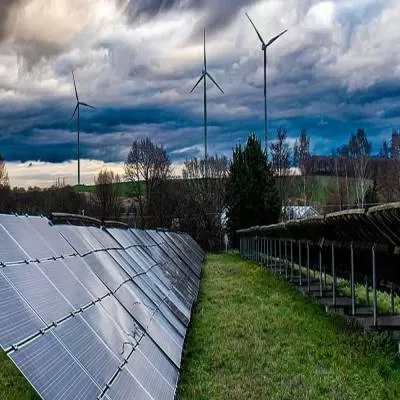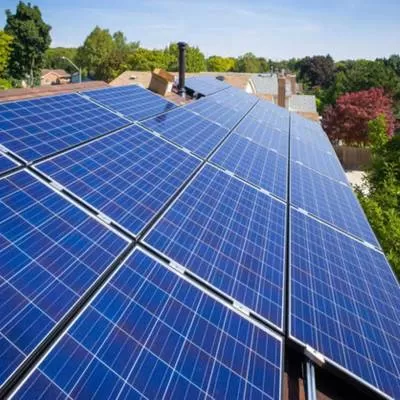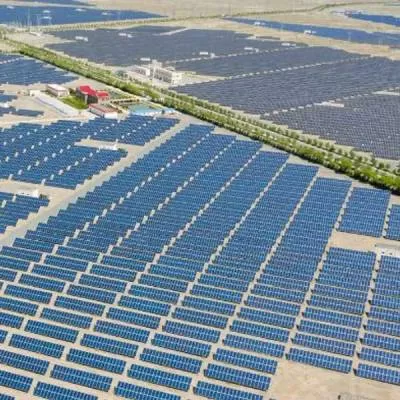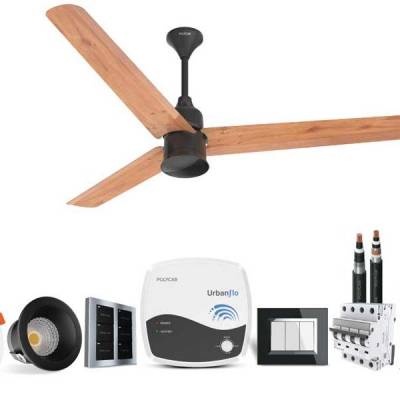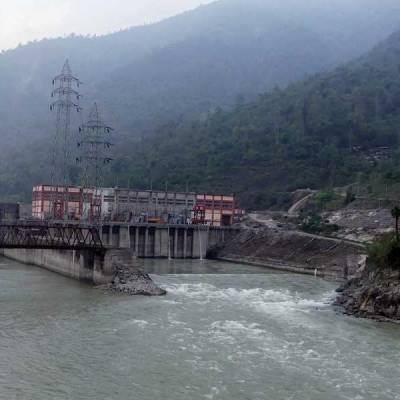- Home
- Infrastructure Energy
- POWER & RENEWABLE ENERGY
- We have offered lending to about 200 projects
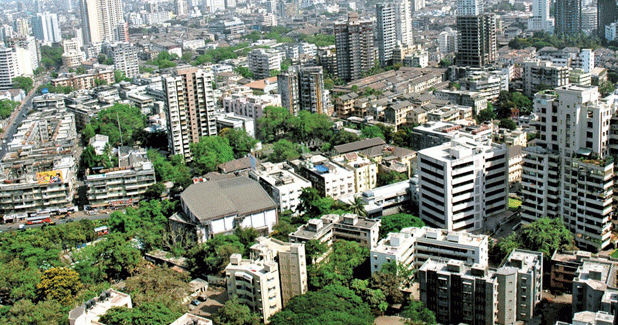
We have offered lending to about 200 projects
The objective was clear: To channel long-term finance to viable infrastructure projects by trying to introduce innovative infra financing products to India. To this end, a special purpose vehicle, India Infrastructure Finance Company Ltd (IIFCL), was set up in 2006. The sectors eligible for financial assistance from IIFCL include transportation, energy, water, sanitation, communication, and social and commercial infrastructure. Further, IIFCL has been registered as a NBFC-ND-IFC with RBI since September 2013. SB Nayar, Chairman & Managing Director, IIFCL, shares his views on the current infrastructure funding scenario and highlights innovative lending schemes in conversation with SHRIYAL SETHUMADHAVAN.
Please shed some light on the present infrastructure financing scenario in India.
The infrastructure financing scenario had slowed down in the past couple of years with not many new projects being rolled out. Hence, many lenders have either reached sectoral caps or are facing substantial restructuring in their existing infrastructure portfolio. In two out of every three projects, there is a cost overrun owing to project delays. Now RBI has also introduced a guideline stating that only up to 10 per cent of the cost overrun can be financed without affecting asset status. As the promoters fail to bring in the finance for the balance portion in many cases, banks also don´t lend to even viable projects and the best of the projects become a non-performing asset (NPA) due to insufficient finance.
At IIFCL, we do a lot of takeout financing after construction to improve the portfolio substantially. Our sanctions are near 300 per cent more than last year. Our advances level has also grown by nearly more than 20 per cent this year.This indicates the largest growth in infrastructure sector financing. But the overall NPA risk still exists as many power projects have either lost a coal mine or are not able to get coal. Unless the guidelines for new coal allocation are in place, lenders are hesitant to release the balance money and the discoms continue to face financial challenges. That said, on a positive note, it is expected that in six months to a year´s time, uncertainties should go away, and thermal power sector, especially, will grow.
What does takeout financing entail?
Takeout finance is aimed at addressing the asset-liability mismatch and exposure constraints faced by banks. It involves taking out a loan from the books of banks, transferring risk to IIFCL and freeing up the banks´ capital for investing in new infrastructure projects. In takeout finance, disbursement generally takes place one year after the actual commercial operation date (COD). IIFCL can take exposure for up to 30 per cent of the project cost, including direct lending.
Introduce us to the ´5 by 25´ scheme that you have designed.
Initially, banks, while lending, had a deposit profile of five to 10 years, as a result of which they would not lend for more than 10 years. This worked fine for small projects. But for a project worth say Rs 6,000 crore to Rs 10,000 crore, it takes four to five years to implement and there after it could be further delayed. And the promoter or developer is forced to pay back in six to seven years, which is impossible. Even if there is a slight fall in revenue, the account gets restructured. So banks were witnessing a huge restructuring portfolio, which was not really required. Considering that the life of a hotel, power or similar project will be 25-30 years, it is possible even for the lenders to finance for over the asset life. The repayment instalment is almost halved. So even if there is a slight fall in revenue, it does not become a restructured account. For example, in the roads sector, if the developer is given 25 years to repay the loan, toll rates would reduce as well, further benefitting users. S,for lenders, restructuring diminishes; the internal rate of return (IRR) goes up for the developer as the cash surplus goes up; and for the users, the toll comes down. It becomes a win-win situation for all. This is seen as a game-changer by the entire industry and should help investments.
Also, recovery of NPAs is seen as a major area of concern in the infrastructure sector. What is IIFCL´s current level of NPA?
We have about 3.51 per cent gross NPAs and 2.24 per cent of net NPAs, which is quite low as IIFCL is a pure infrastructure company. This cannot be avoided as we are a consortium, and hence an NPA of another lender becomes our NPA. So, for instance, with several power projects not getting a coal mine, the NPA´s could still go up, the restructuring is still not over.
Elaborate upon your current lending portfolio for the infrastructure sector.
We have a direct loan where we join in consortium with other people. Then, along with takeout financing, we have a sub-debt (mezzanine debt). Here, in the case of equity shortage, we give a sub-debt loan, which helps the developer improve the IRR and delivery. Then we have the credit guarantee scheme -we give a credit guarantee and the company´s bond goes from BBB to AA or higher. Then the company can go to the bond market and place the long-term bonds at cheaper rates. We also have multilateral loans, given by way of refinancing.
What sectors do you prefer lending to?
There are no preferred sectors. We look at good projects, not good sectors. We have offered lending to about 200 projects. However, power is facing a challenge because many projects financed by us are based on coal mine allocation or coal linkage, which is now not there for these projects. Also, there are several road sectors where land is not available, and hence projects are delayed leading to cost overrun. So these two sectors are highly stressed.
What are your fund raising plans?
We do not have any immediate plans as we have enough liquidity. However, when the investment picks up and as new projects come up - which is now happening at a slow pace - we may consider it. We are an AAA-rated company because of which we can raise money anytime.
Further, as the government has decided to bring upon tax-free bonds, how much will IIFCL raise through the same?
We have not decided anything yet because we need projects. Also, we need to look at how fast solar energy investment takes off. The market for solar looks fine, provided discoms improve the financial health and transmission capacity is built-up.
IIFCL is working towards setting up its second infrastructure debt fund. How much will be raised and which sectors will be focused upon?
We are looking at two funds: One for the general infrastructure sector and the other for renewable energy. The amount to be raised will be determined by the investors´ interest. We are in the process of talking to investors. But this will be substantially bigger than our pilot fund, which was Rs 300 crore.
Can you elaborate upon the pilot scheme of credit enhancement offered by IIFCL?
IIFCL provides its partial credit guarantee to enhance the credit rating of bonds (for refinancing of existing loans) of infrastructure companies. The rating enhancement enables channelling of long-term funds from investors like insurance and pension funds in the infrastructure sector. Also, the Asian Development Bank (ADB) is providing backstop guarantee facility to IIFCL for up to 50 per cent of IIFCL´s underlying risk.
Could you take us through your disbursement and sanction plans?
Our sanction is already 300 per cent more than last year. After the Twelfth Five-Year plan started in 2012, our sanctions are Rs 33,397.53 crore, of which Rs 22,954.50 crore are for new projects and Rs 10,443.03 crore is for takeout financing.
To share your lending experience with us, write in at feedback@ASAPPmedia.com
- SB Nayar, Chairman & Managing Director, IIFCL The objective was clear: To channel long-term finance to viable infrastructure projects by trying to introduce innovative infra financing products to India. To this end, a special purpose vehicle, India Infrastructure Finance Company Ltd (IIFCL), was set up in 2006. The sectors eligible for financial assistance from IIFCL include transportation, energy, water, sanitation, communication, and social and commercial infrastructure. Further, IIFCL has been registered as a NBFC-ND-IFC with RBI since September 2013. SB Nayar, Chairman & Managing Director, IIFCL, shares his views on the current infrastructure funding scenario and highlights innovative lending schemes in conversation with SHRIYAL SETHUMADHAVAN. Please shed some light on the present infrastructure financing scenario in India. The infrastructure financing scenario had slowed down in the past couple of years with not many new projects being rolled out. Hence, many lenders have either reached sectoral caps or are facing substantial restructuring in their existing infrastructure portfolio. In two out of every three projects, there is a cost overrun owing to project delays. Now RBI has also introduced a guideline stating that only up to 10 per cent of the cost overrun can be financed without affecting asset status. As the promoters fail to bring in the finance for the balance portion in many cases, banks also don´t lend to even viable projects and the best of the projects become a non-performing asset (NPA) due to insufficient finance. At IIFCL, we do a lot of takeout financing after construction to improve the portfolio substantially. Our sanctions are near 300 per cent more than last year. Our advances level has also grown by nearly more than 20 per cent this year.This indicates the largest growth in infrastructure sector financing. But the overall NPA risk still exists as many power projects have either lost a coal mine or are not able to get coal. Unless the guidelines for new coal allocation are in place, lenders are hesitant to release the balance money and the discoms continue to face financial challenges. That said, on a positive note, it is expected that in six months to a year´s time, uncertainties should go away, and thermal power sector, especially, will grow. What does takeout financing entail? Takeout finance is aimed at addressing the asset-liability mismatch and exposure constraints faced by banks. It involves taking out a loan from the books of banks, transferring risk to IIFCL and freeing up the banks´ capital for investing in new infrastructure projects. In takeout finance, disbursement generally takes place one year after the actual commercial operation date (COD). IIFCL can take exposure for up to 30 per cent of the project cost, including direct lending. Introduce us to the ´5 by 25´ scheme that you have designed. Initially, banks, while lending, had a deposit profile of five to 10 years, as a result of which they would not lend for more than 10 years. This worked fine for small projects. But for a project worth say Rs 6,000 crore to Rs 10,000 crore, it takes four to five years to implement and there after it could be further delayed. And the promoter or developer is forced to pay back in six to seven years, which is impossible. Even if there is a slight fall in revenue, the account gets restructured. So banks were witnessing a huge restructuring portfolio, which was not really required. Considering that the life of a hotel, power or similar project will be 25-30 years, it is possible even for the lenders to finance for over the asset life. The repayment instalment is almost halved. So even if there is a slight fall in revenue, it does not become a restructured account. For example, in the roads sector, if the developer is given 25 years to repay the loan, toll rates would reduce as well, further benefitting users. S,for lenders, restructuring diminishes; the internal rate of return (IRR) goes up for the developer as the cash surplus goes up; and for the users, the toll comes down. It becomes a win-win situation for all. This is seen as a game-changer by the entire industry and should help investments. Also, recovery of NPAs is seen as a major area of concern in the infrastructure sector. What is IIFCL´s current level of NPA? We have about 3.51 per cent gross NPAs and 2.24 per cent of net NPAs, which is quite low as IIFCL is a pure infrastructure company. This cannot be avoided as we are a consortium, and hence an NPA of another lender becomes our NPA. So, for instance, with several power projects not getting a coal mine, the NPA´s could still go up, the restructuring is still not over. Elaborate upon your current lending portfolio for the infrastructure sector. We have a direct loan where we join in consortium with other people. Then, along with takeout financing, we have a sub-debt (mezzanine debt). Here, in the case of equity shortage, we give a sub-debt loan, which helps the developer improve the IRR and delivery. Then we have the credit guarantee scheme -we give a credit guarantee and the company´s bond goes from BBB to AA or higher. Then the company can go to the bond market and place the long-term bonds at cheaper rates. We also have multilateral loans, given by way of refinancing. What sectors do you prefer lending to? There are no preferred sectors. We look at good projects, not good sectors. We have offered lending to about 200 projects. However, power is facing a challenge because many projects financed by us are based on coal mine allocation or coal linkage, which is now not there for these projects. Also, there are several road sectors where land is not available, and hence projects are delayed leading to cost overrun. So these two sectors are highly stressed. What are your fund raising plans? We do not have any immediate plans as we have enough liquidity. However, when the investment picks up and as new projects come up - which is now happening at a slow pace - we may consider it. We are an AAA-rated company because of which we can raise money anytime. Further, as the government has decided to bring upon tax-free bonds, how much will IIFCL raise through the same? We have not decided anything yet because we need projects. Also, we need to look at how fast solar energy investment takes off. The market for solar looks fine, provided discoms improve the financial health and transmission capacity is built-up. IIFCL is working towards setting up its second infrastructure debt fund. How much will be raised and which sectors will be focused upon? We are looking at two funds: One for the general infrastructure sector and the other for renewable energy. The amount to be raised will be determined by the investors´ interest. We are in the process of talking to investors. But this will be substantially bigger than our pilot fund, which was Rs 300 crore. Can you elaborate upon the pilot scheme of credit enhancement offered by IIFCL? IIFCL provides its partial credit guarantee to enhance the credit rating of bonds (for refinancing of existing loans) of infrastructure companies. The rating enhancement enables channelling of long-term funds from investors like insurance and pension funds in the infrastructure sector. Also, the Asian Development Bank (ADB) is providing backstop guarantee facility to IIFCL for up to 50 per cent of IIFCL´s underlying risk. Could you take us through your disbursement and sanction plans? Our sanction is already 300 per cent more than last year. After the Twelfth Five-Year plan started in 2012, our sanctions are Rs 33,397.53 crore, of which Rs 22,954.50 crore are for new projects and Rs 10,443.03 crore is for takeout financing. To share your lending experience with us, write in at feedback@ASAPPmedia.com


